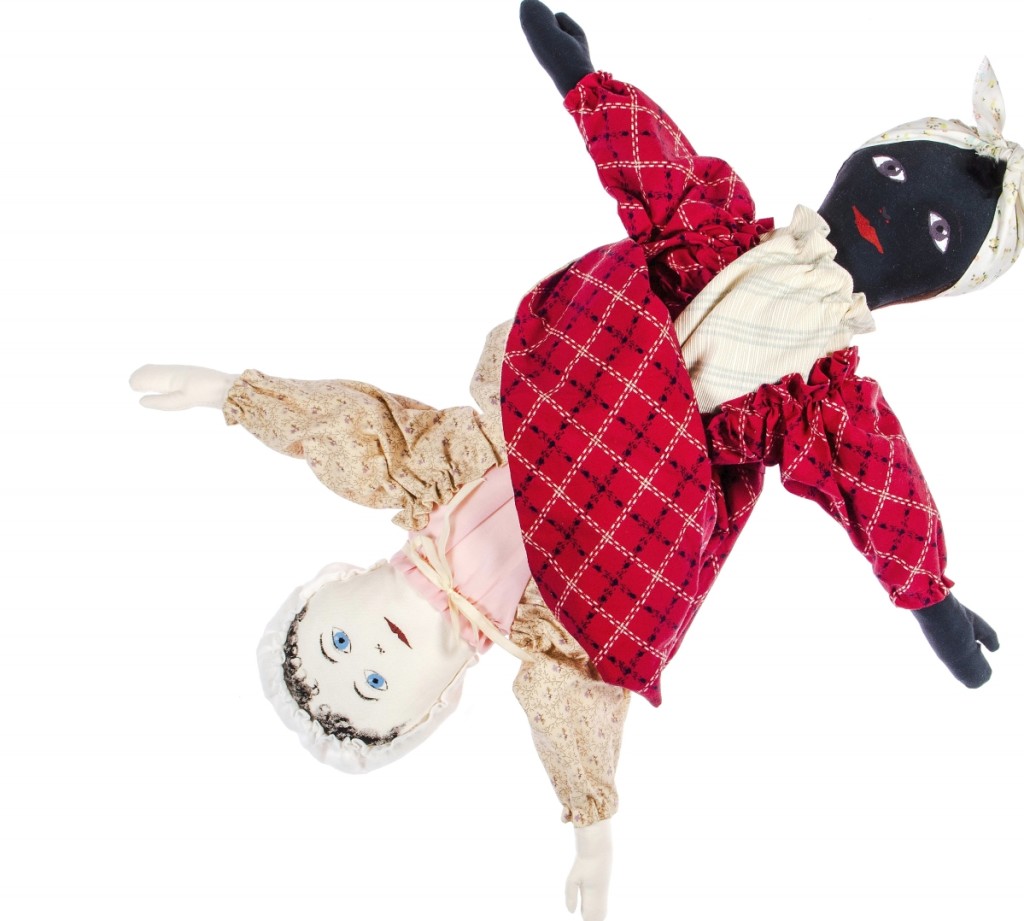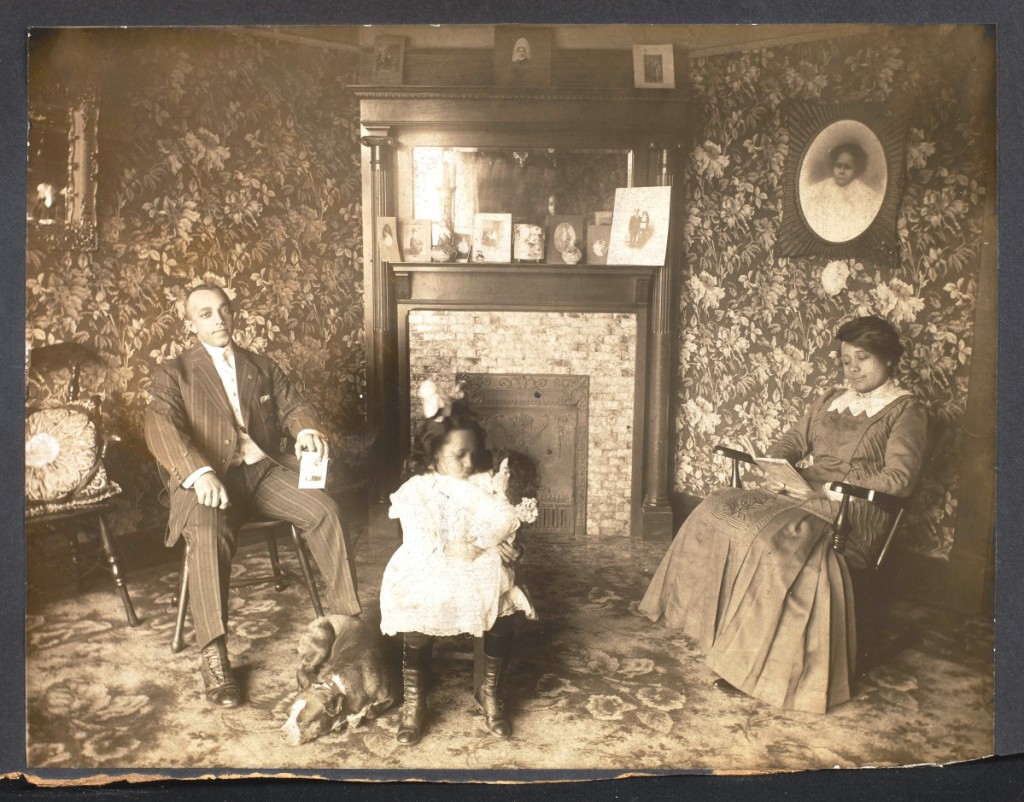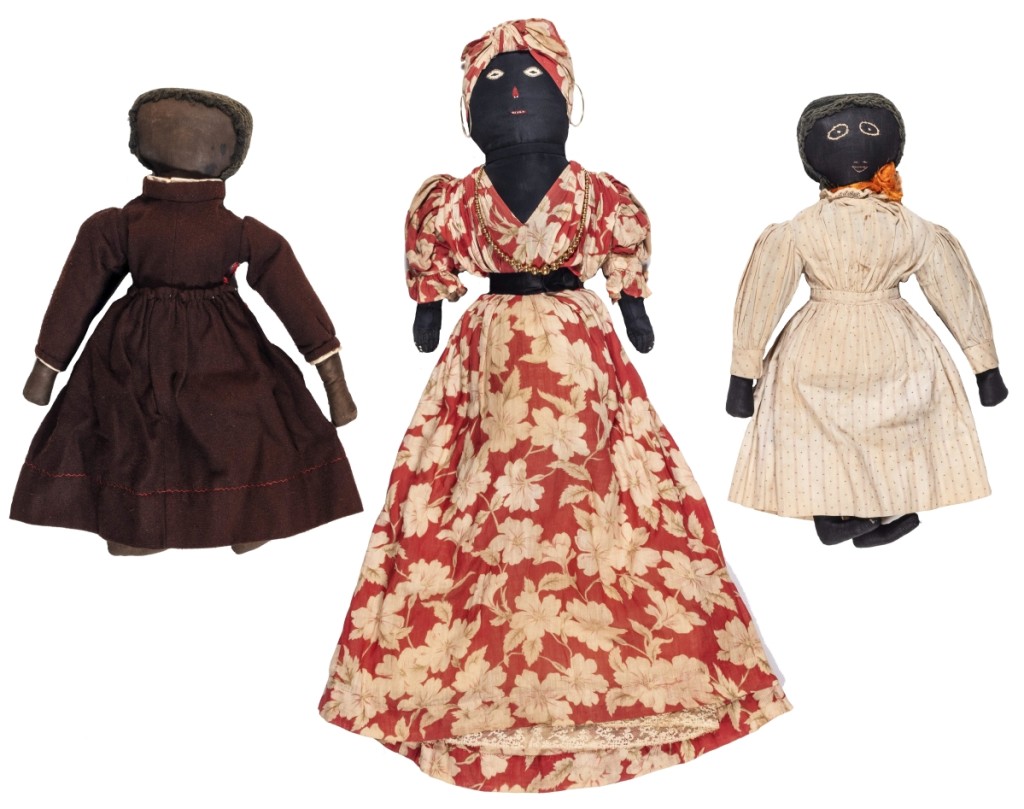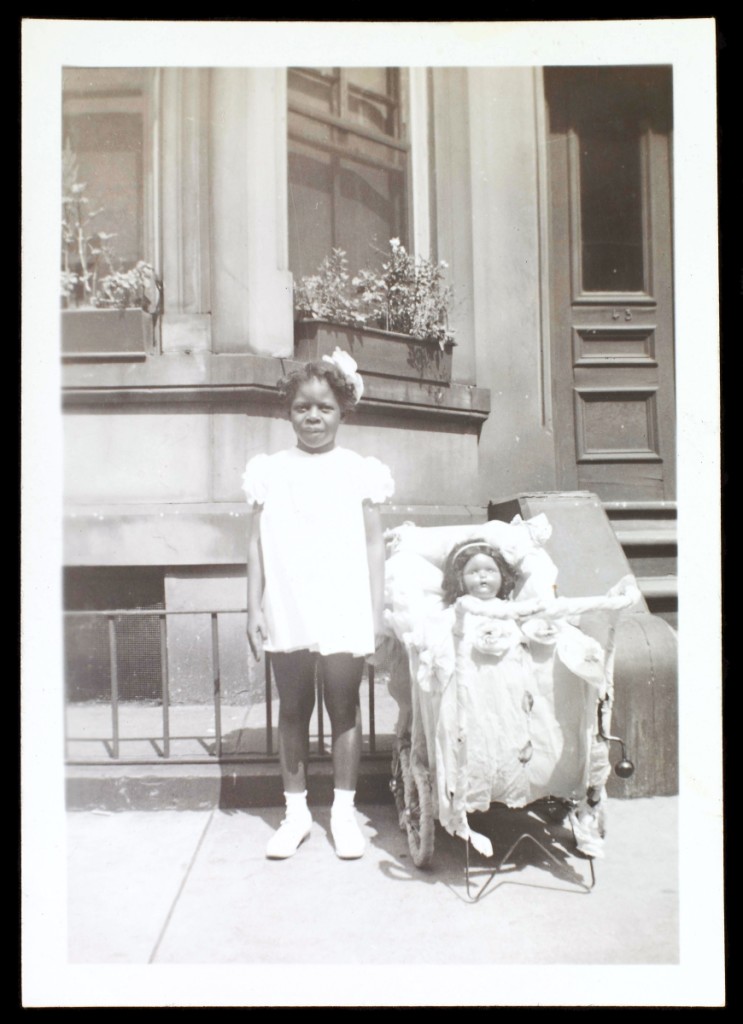
Topsy-turvy doll, 1890-1905. Mixed fabrics, paint. New-York Historical Society, Gift of Katharine Prentis Murphy.
—Glenn Castellano photo
By Karla Klein Albertson
NEW YORK CITY – Often people state, when something is clear cut, that it is “right there in black and white.” “Black Dolls,” an exhibition at the New-York Historical Society through June 5, explores how this statement can apply even to evidence from the innocent world of children’s play. The exhibits range from early handmade dolls created by African American women for their own children to the Twentieth Century commercial toys designed for a rising market of Black consumers who wanted representative playthings.
Visitors entering the gallery read: “Expressions of resilience and creativity, perseverance and pride, love and longing: The handmade Black dolls that populate this exhibition have a lot to say. Stitched largely by Black women for their own children or white youngsters under their care, the dolls were ingeniously crafted from materials at hand. Their faded clothing, torn bodies and sundry repairs evoke vigorous play and lost conversations, and call up images of the children that cuddled, pampered and mistreated them. Made in the United States between the 1850s and the 1940s, these dolls span a tumultuous period in American history marked by slavery, legalized segregation and entrenched racism. These works are mute about their specific histories, yet every stitch and swatch were a deliberate choice. The makers, mostly unknown to us, created toys that expressed their inner lives and intangible feelings while challenging pervasive stereotypes.”
Dolls of this sort, which have survived without written documentation, fit into a long archaeological history of parental affection, where mothers and fathers would carve, model or sew playthings for their children in the likeness of their own people. They can be found in excavations dating back into prehistory. As societies became more socially and racially stratified, professional dollmakers produced upper class dolls for the wealthy, while those with less wealth continued to make do with homemade models. Whether the time frame is ancient Rome or previous centuries in America, the mechanism continued until the modern commercial era of super doll diversity.
The New York show forcefully illustrates its points with more than 200 objects, including 110 handmade dolls and period photographs from well-known collector Deborah Neff, along with Twentieth Century commercial dolls and related exhibits and ephemera from the New-York Historical Society and other collections. The exhibition was organized by Margi Hofer, vice president and museum director, and associate curator Dominique Jean-Louis.

Domestic scene by J.C. Patton, Indianapolis, Ind., circa 1915. Gelatin silver print. Deborah Neff Collection.
—Ellen McDermott photo
In a conversation with Antiques and The Arts Weekly, Jean-Louis spoke about the organizational background: “We began the work on this exhibition in the spring of 2019, so it’s been quite a while. We’ve been doing as much research as we possibly can and reaching out to people who can help us think through the range of kinds of dolls which are in this exhibition. We definitely started by immersing ourselves in the wide body of research, and then from there working to help people ask the right questions. And now that everything is installed, I see that this exhibition may ask more questions than it answers.
“Everyone will bring their own perspective. Some people will look at these dolls and find only charm and affection; others will see something entirely different. It’s not for us to say what is the correct perspective but to provide accurate history, to provide accurate examples from the visual culture of the time period. People may look at them for the first time in a different way, as an artifact or archive of things that were sometimes subjugated to the margins.”
The section on “The Art and Craft of Dollmaking” shows off the dazzling creativity of family and friends working with materials at hand to create a plaything with personality for a favorite child. As is the case with quilts, we often have no name for the artist, only the handiwork that survived. Costumes for the Black dolls range from everyday work clothes to elegant attire as worn by a gentleman in a frock coat, 1860-70, from Milton, Mass., part of the Deborah Neff Collection pieces.
Jean-Louis pointed out one favorite exhibit where we can put a name and history to artifacts: “I think that one of the standout moments in the exhibition are the three dolls that were handmade by Harriet Jacobs (1813-1897), who, of course, is renowned for her memoire – Incidents in the Life of a Slave Girl – that chronicles her traumatic experience of enslavement.” The volume had been published in 1861. A most unusual fact was that the family which had owned her had taught her to read and write as well as sew.
The curator continued, “She was also a dollmaker. When she escaped enslavement and started working for a New England family, she made dolls for the children that stayed in the family for generations. What’s so remarkable about that for me is we have them displayed right next to Harriet Jacobs’ book. It is very rare that we have a woman who lived through enslavement, who could read and write, who could speak in her own words about her experiences – but then we have these dolls. If she hadn’t been taught to read and write, if she’d never been able to publish her book, that might be all that’s left of her.

Dolls made for the Willis family by Harriet Jacobs (1813-1897), circa 1850-60. Mixed fabrics, metal. Private Collection. —Glenn Castellano photo
“Those are only three dolls, but there are more than 100 in the exhibition and each one of those dolls was made by someone, somebody who has a life history, who possibly had a story that could have changed the world as Harriet Jacobs’ did. This is one case where the dolls were survivors, they were safe-guarded, they were legacies to be preserved. Sadly, for the vast majority of dolls and dollmakers, we don’t have as much history of their lives as we’d like to.”
In the section titled “Race Play,” visitors are confronted with a selection of the unsettling topsy-turvy dolls, which – with a flip of the skirt – change from a white torso to a black torso. Definite a clear-cut issue of black and white. The wall text quotes W.E.B. DuBois’ statement in The Souls of Black Folk (1903) “that the problem of the Twentieth Century is the problem of the color-line.”
These cloth dolls began to appear in the late Nineteenth Century and could still be found by tourists in Southern souvenir stands well into the mid-Twentieth Century. Children were made to literally play with a distinct color line – were the topsy-turvy women friends or opponents? They could never escape their bond. “Those kinds of questions have always been a fixture in national conversations about these dolls,” said Jean-Louis. “The color line is not a fluid thing, it’s a hard line between black and white.”
The first decades of the Twentieth Century brought changes in Civil Rights Movements that had an effect that even reached into the fantasy world of doll play. The National Negro Doll Company, founded in 1908 by Richard Henry Boyd, began manufacturing Black dolls with a positive image, and another venture was started in Harlem by businesswomen Evelyn Berry and Victoria Ross.

“Girl with stroller” by unidentified photographer, Boston, 1930-40. Gelatin silver print. Deborah Neff Collection.
—Ellen McDermott photo
The NAACP had been founded in 1909, and doll companies supported it, according to the curator: “There is a close relationship between the early days of the Black press and national Civil Rights organizations, and the earliest manufacturers of Black dolls. The personal decisions of where your dollar is going and what your children are surrounded with were political decisions as well. This is not just a doll – this is a larger symbol of social mobility.” The final exhibits of modern choices available for realistic Black dolls with authentic accessories show the completion of the journey.
“Every time I walk through the gallery, I pause there and have a moment of gratitude that I have a chance to commune with that history,” Jean-Louis said in conclusion.
“One of the things the exhibition does is to encourage us to look at these items from the domestic sphere as documents of history. The items we surround ourselves with – that we make, that we bring from the imagination to the real world – those are documents of history that deserve close study and celebration and appreciation, as much as a handwritten letter by Thomas Jefferson. Another important consideration is just thinking about childhood and how we receive messages as children that stay with us. This exhibition is for anyone who is a child or who has ever been a child, which is everyone.”
Further bibliography:
“Black Dolls: the Deborah Neff Collection” was a 2018 exhibition at La Maison Rouge in Paris, which received international press attention, including a splash in Vogue. The catalog in French and English has an introduction by Nora Philippe, an interview with Neff about her collection, and related essays by contributors. Also, a rare earlier volume – Black Dolls: Unique African American dolls, 1850-1930 from the Collection of Deborah Neff (2015) edited by Frank Maresca – was published in connection with an exhibition at the Mingei International Museum in San Diego, Calif. Information about acquiring these two volumes can be found at the New-York Historical Society online shop and through booksellers online.
The New-York Historical Society Museum & Library is at 170 Central Park West at Richard Gilder Way (77th Street). For information, www.nyhistory.org or 212-873-3400.



















